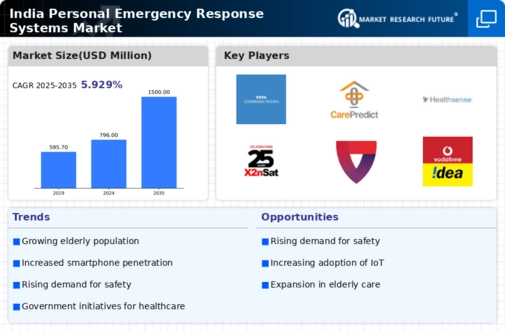The personal emergency-response-systems market is currently characterized by a dynamic competitive landscape, driven by an increasing demand for safety and security solutions among aging populations and individuals with health concerns. Key players such as Philips Lifeline (US), Medical Guardian (US), and ADT Inc. (US) are strategically positioning themselves through innovation and partnerships. Philips Lifeline (US) has focused on enhancing its product offerings with advanced technology, while Medical Guardian (US) emphasizes user-friendly devices that cater to a diverse demographic. ADT Inc. (US) leverages its extensive security infrastructure to integrate emergency response systems, thereby creating a comprehensive safety solution that appeals to a broad customer base. Collectively, these strategies contribute to a competitive environment that prioritizes technological advancement and customer-centric solutions.
In terms of business tactics, companies are increasingly localizing manufacturing to reduce costs and improve supply chain efficiency. This approach not only enhances responsiveness to market demands but also aligns with regional preferences. The market structure appears moderately fragmented, with several players vying for market share. However, the influence of major companies is significant, as they set benchmarks for quality and innovation that smaller firms strive to meet.
In October 2025, Medical Guardian (US) announced a partnership with a leading telehealth provider to integrate remote health monitoring into its emergency response systems. This strategic move is likely to enhance the value proposition of their offerings, allowing users to access medical assistance seamlessly during emergencies. By combining emergency response with telehealth services, Medical Guardian (US) positions itself as a comprehensive health management solution, potentially attracting a wider customer base.
In September 2025, Philips Lifeline (US) launched a new line of wearable devices equipped with fall detection and GPS tracking features. This innovation not only addresses the critical needs of its users but also reflects a broader trend towards integrating advanced technology into personal safety solutions. The introduction of these devices may strengthen Philips Lifeline's market position by appealing to tech-savvy consumers who prioritize functionality and reliability in emergency response systems.
In August 2025, ADT Inc. (US) expanded its service offerings by acquiring a regional emergency response company, thereby enhancing its operational capabilities and market reach. This acquisition is indicative of a trend where larger firms seek to consolidate their positions through strategic acquisitions, allowing them to offer more comprehensive services and improve customer retention. Such moves may also lead to increased competition as these companies strive to differentiate themselves in a crowded market.
As of November 2025, the competitive trends in the personal emergency-response-systems market are increasingly defined by digitalization, AI integration, and a focus on sustainability. Companies are forming strategic alliances to enhance their technological capabilities and expand their service offerings. The shift from price-based competition to a focus on innovation and technology is evident, as firms recognize the importance of reliability in supply chains and the need for advanced solutions that meet evolving consumer expectations. Looking ahead, competitive differentiation is likely to hinge on the ability to innovate and adapt to changing market dynamics, with a strong emphasis on integrating technology into user-friendly solutions.






















Leave a Comment